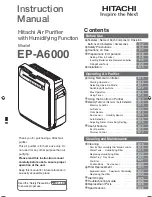
37
YORK INTERNATIONAL
3
FORM 100.50-NOM1 (604)
13. Verify proper belt tension of sup ply fan, ex haust
fan or return fan
(refer to Main te nance section of
man u al).
Belts must be checked after 24 hours of
initial op er a tion.
14. Manually rotate condenser fan blades, supply
exhaust and return blower wheels and motors, to
assure freedom of movement.
15. Verify proper condensate drain trap in stal la tion
(re fer to Figure 4). Fill traps with water pri or to
unit start-up.
16. If applicable, verify in stal la tion of air
Þ
lters (refer
to In stal la tion section for size and quantity).
17. Verify Variable Frequency Drive setpoints for
VAV units and optional Variable Frequency Drive
Ex haust or Return Fans. Both VFD’s are located
in the supply blow er sec tion of the unit.
Refer
to separate man u al for VFD op er a tion and pro-
gramming, supplied with the rooftop unit (Form
100.40-N04).
18. If equipped, open suction line ball valve, discharge
line ball valve, and liquid line ball valve for each
refrigerant system.
UNIT CHECKS – POWER APPLIED
1. Apply 3-phase power and verify its value. Volt-
age im bal ance should be no more than 2% of the
av er age volt age.
2. Verify programmed units Setpoints
(refer to
“Quick Start-Up Guide”, Form 100.50-N01).
3. Verify correct fan rotation – fan should rotate in
direction of arrow on fan housing.
4. Insure proper com pres sor ro ta tion - see following
in struc tion on
Ver i fy ing Compressor Ro ta tion.
Verifying Com pres sor Rotation
This unit uses scroll compressors,
which will only operate in one di-
rec tion. Fail ure to observe these steps
could lead to com pres sor failure.
The eco
2
rooftop unit uses hermetic scroll com pres sors,
which only pump in one di rec tion. There fore, it is nec-
es sary to verify proper ro ta tion at unit start-up. Op-
er a tion of the com pres sor in the reverse di rec tion will
not pro duce any ca pac i ty, and cause the com pres sor to
cycle on in ter nal over load. Op er at ing the com pres sor
in re verse for “ex tend ed” pe ri ods can result in fail ure
of the com pres sor.
To verify proper rotation, monitor the suc tion and
dis charge pressures of the re spec tive refrigerant cir-
cuit while the com pres sor cycles on. If the discharge
pres sure increases and suction pressure decreases as
the compressor cycles on, the compressor is properly
phased and operating in the correct rotation.
Suction and discharge pressure may be monitored with
the OptiLogic
TM
display if the optional suction and dis-
charge pres sure transducers are installed (refer to the
section on Menu Navigation). If the op tion al trans duc ers
are not in stalled, pres sures must be monitored with a
man i fold gauge connected to the service valves lo cat ed
on the suction and dis charge lines.
Upon initial application of power to
the roof top unit, there is a three min-
ute period of non unit operation as the
Primary Unit Con trol ler goes through
a self-test pe ri od. Dur ing this time, it
will not re spond to key pad se lec tions.
After three min utes, the dis play will
re vert to unit con fi g u ra tion and allow
nor mal op er a tion of the rooftop unit.
Compressor Oil Level Check
The oil level can only be tested when the com pres sor
is running in stabilized con di tions, to ensure that there
is no liquid refrigerant in the lower shell of the com-
pres sor. When the compressor is run ning in stabilized
con di tions, the oil level must be be tween 1/2 and 3/4 in
the oil sight glass.
Note: at shut down, the oil level can
fall to the bot tom limit of the oil sight glass.
FIG. 13 –
SUPPLY FAN ISOLATOR SPRING BOLTS
(TOTAL OF 8)
00496VIP
















































